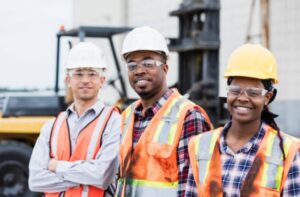
How increasing safety measures allow construction projects to be more diverse
Improved safety measures can help provide more inclusive policies, paving the way for more inclusion and a stronger workforce
The construction industry faces safety challenges every day. Employees work with heavy machinery at higher heights, and falls are the most common injury for workers. Increasing safety measures is critical on many levels. It also allows more staff members to get involved in projects, increasing diversity.
 Lack of diversity in the workforce
Lack of diversity in the workforce
The construction industry tends to have a larger portion of white males. Some people see physical labor as more of a man’s job and, in fact, only 10.3 percent of workers in the construction industry are women. Many of them take on sales or office roles.
Minorities can also face discrimination. Only 6.3 percent of construction workers are Black, and some people may experience incidents of prejudice and discriminatory behavior.
The causes
The construction industry has been slower in adopting inclusive policies. Here are some of the potential reasons why.
1. Lack of support from management
Strong leadership is needed for an inclusive environment, and managers can foster inclusion through recruitment and company culture. They can use their social capital and budget to implement change.
However, some leaders don’t buy into an inclusive environment. They may focus more on turning profits than creating a diverse workforce. Diversity should be naturally built into the company’s culture.
2. Ineffective inclusion policies
Most businesses may have a diversity and inclusion program. However, these may not be fully fleshed out. Having a policy in place is only the first step. There should be strong anti-harassment and discrimination policies, including online behaviors. Management should ensure prohibited actions are thoroughly explained and the policy enforcement is consistent.
Here are a few more strategies to create diverse policies:
● Reinvent the standards for awarding promotions.
● Reevaluate benefits like sick pay, vacation time, and maternity and paternity leave.
● Take a closer look at work-life balance.
● Create training programs for unconscious bias, cultural intelligence and active bystander training.
3. Less diverse recruiting practices
Many industries fall into the trap of hiring the same type of employees. Tech companies might pull recruits from the same schools each year, while construction organizations rely on traditional practices and skill structures. This can eliminate people who may not fit the conventional standards.
Recruiters may discount those with disabilities because physical labor is more challenging for them. However, building a diverse team is essential to creating a more productive workflow.
Companies should work with inclusive trade groups or apprenticeship programs. They should also network with the community and attend professional events. Once a recruiter finds talent, they can make the hiring process more inclusive, beginning by removing exclusive language from the job description.
Companies can follow these steps:
● Write descriptions to get people interested in the job and focus less on a specific skill set.
● Consider a blind resume review system.
● Change the onboarding process to make it feel welcoming and inclusive.
● Share details about the company culture on its website.
4. Concerns with workplace harassment, bullying and violence
Workplace harassment can be an issue when fewer minorities and women are in construction. Gender-based and racial violence can affect employees’ mental health and cause safety concerns. In fact, 21 percent of construction employees experienced bullying in 2021.
These incidents can make it harder to expand a company’s workforce. To start, all organizations should constantly reinforce zero-tolerance policies. In addition, management should have conversations about bullying and implement bystander training.
How employee safety can help
Lack of managerial support and effective policies makes inclusion a challenge in construction. Here are some ways safety programs can help.
1. Training programs provide equal access
On-site training is essential to keep employees safe. Companies should consider assigning a safety patrol officer to the job sites. They can check in with employees and address any concerns. The officer should ensure workers wear properly fitted and fastened gear. Another part of the role is educating workers on best practices in fall protection. Ensuring all employees have access to proper training creates a safe environment.
Each new hire should be matched with a mentor to encourage more women and minorities to apply. This can give them somebody to talk to and feel comfortable sharing their concerns. Ensuring new teammates feel valued can reduce turnover.
2. More snug-fitting gear keep employees safe
Much personal protective equipment (PPE) in the construction industry is designed for men, and it can be hard for women to find ones that fit well. For example, finding a smaller vest may be challenging.
Improperly fitted gear can lead to safety concerns, such as whiplash or joint damage. Managers with more men on the team might not consider ordering different-sized equipment, and some women may not mention their concerns. Leaders must buy harnesses in multiple sizes and ask for female employee feedback.
3. Using technology encourages an inclusive environment
Bringing innovation into the industry can welcome people from diverse backgrounds. Many people assume they need to be strong, leading to discrimination against women. However, technology shows this isn’t always the case. Businesses need people with technical skills, regardless of gender or race.
Another key piece is advanced data collection methods. These can help contractors decide the best people to put on the job. The systems provide historical records of what subcontractors regularly meet safety standards, preventing unconscious bias and allowing the best person to take on the job.
4. Stronger leadership can implement change
Leadership that creates more inclusive policies is essential. It starts by creating a culture of diversity and acceptance. One way is to look at current employer policies, such as maternity leave. As more women enter this field, companies should consider expanding their policies.
They must also ensure pregnant women aren’t exposed to chemicals while on the job site.
An annual meeting discussing sexual harassment and unconscious bias is also critical. Strong company leadership is vital to encourage other employees to take action.
5. Use resources and funding to help diversity efforts
Diversity and inclusion programs should be part of the business’s everyday work. Allocating time and resources to safety measures is key. The first step is to work with the budget and get funding. Managers can find grants from government agencies, state organizations and private corporations.
Once the money is in place, companies should invest in programs for diverse workers. For example, they could increase safety equipment for disabled and more senior members. A counselor could help staff with mental health concerns.
Safety and inclusion in the construction industry
The construction industry still needs to make progress in becoming more diverse. Women and minorities face challenges entering this field. Improved safety measures can help provide more inclusive policies and better protective gear, paving the way for more inclusion and a stronger workforce.








